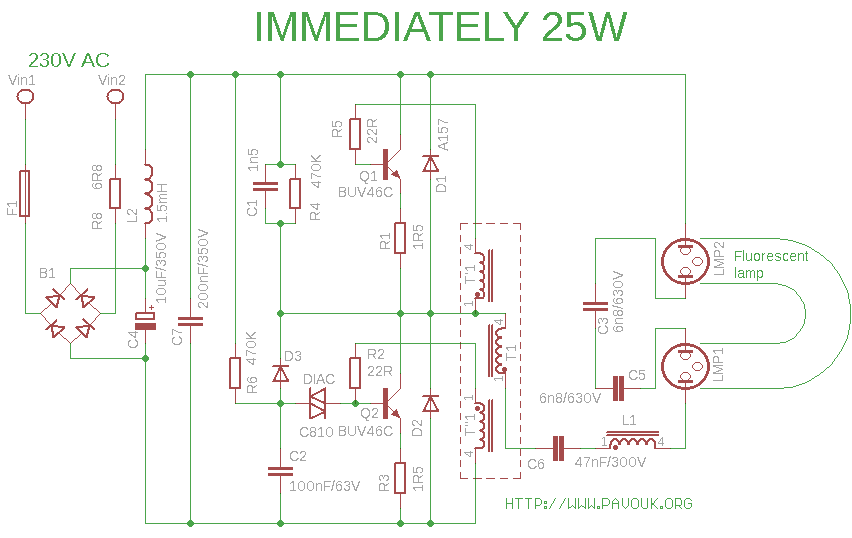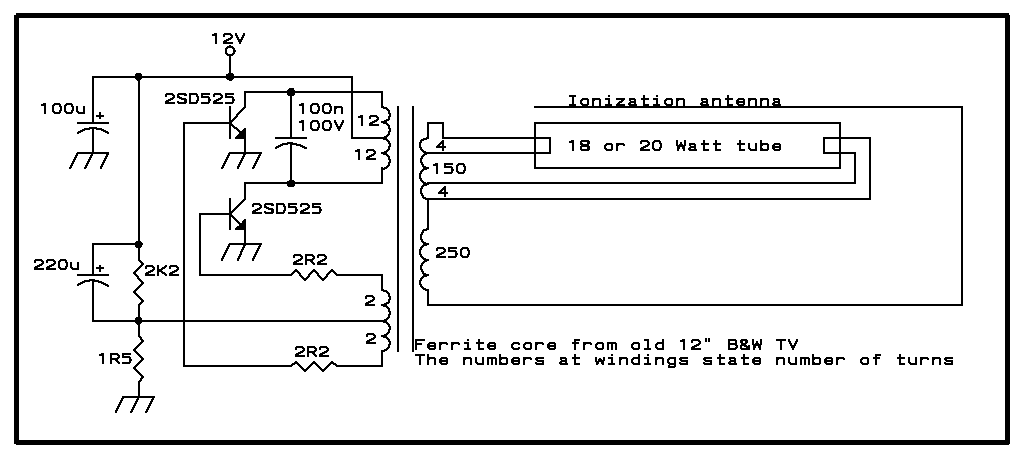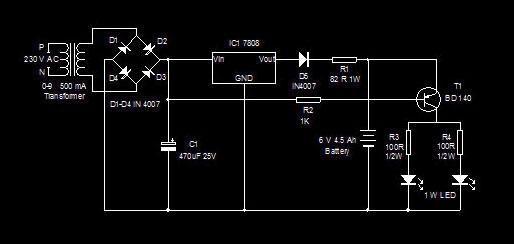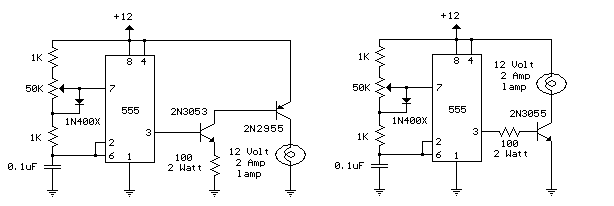
Compact fluorescent lamp

Compact fluorescent lamps offer several advantages over traditional incandescent bulbs, including reduced power consumption (up to 80%) and significantly longer lifespans (5 to 15 times longer). However, they have some drawbacks, such as longer warm-up times, particularly in more expensive models, and limitations in dimming capabilities. The most common type is "warm white," which closely resembles the light of conventional bulbs and is generally more pleasing to the eye. Compact fluorescent lamps utilize a vacuum tube similar to that of a classic fluorescent lamp, and the principle of energy conversion to light is the same. The tube features two electrodes coated with barium at both ends. The cathode operates at a high temperature of approximately 900 degrees Celsius, generating numerous electrons that are accelerated by the voltage between the electrodes, colliding with argon and mercury atoms to create low-temperature plasma. The energy from the excited mercury atoms is emitted in the form of ultraviolet (UV) light. The inner surface of the tube is coated with a phosphor that converts UV light into visible light. These tubes operate on alternating current, which causes the roles of the electrodes (cathode and anode) to switch. A switched converter, operating at tens of kilohertz, prevents the CFL from "flickering," unlike traditional fluorescent tubes. The converter, located in the screw cap, replaces the standard ballast and starter. The operation principle can be illustrated using the LUXAR 11W lamp. The circuit consists of a power supply section that includes an interference suppressor (L2), a fuse (F1), a bridge rectifier made of 1N4007 diodes, and a filtering capacitor (C4). The starting section comprises D1, C2, R6, and a diac. Components D2, D3, R1, and R3 serve protective functions. Other components facilitate normal operation. R6, C2, and the diac generate the initial pulse to the base of transistor Q2, causing it to turn on. Once the lamp starts, this section is blocked by diode D1, preventing further pulses. After each activation of Q2, capacitor C2 discharges, making it impossible to gather enough energy to reactivate the diac. Transistors are then excited through a small transformer (TR1), which consists of a ferrite core with three windings (5 to 10 turns each). The filaments are powered via capacitor C3 from voltage spikes generated by the resonant circuit formed by L1, TR1, C3, and C6. When the tube lights up, the resonant frequency is determined by the capacitance of C3, which is significantly lower than that of C6. At this point, the voltage across C3 exceeds 600V relative to the tube. During startup, the peak collector current can be 3 to 5 times greater than in normal operation. If the tube is damaged, there is a risk of transistor failure. When the gas inside the tube becomes ionized, C3 effectively becomes a short circuit, leading to a decrease in frequency and allowing the circuit to be driven solely by C6, which generates a lower voltage sufficient to maintain illumination. Under normal conditions, when the transistor opens, the current through TR1 increases until the core saturates, at which point feedback to the base diminishes, causing the transistor to close. The second transistor, excited by the reverse-connected winding of TR1, then opens, and the cycle repeats. A common failure is a broken capacitor C3, particularly in lower-quality lamps that use cheaper components rated for lower voltages. If the tube fails to light up promptly, there is a risk of damaging transistors Q1 and Q2, as well as resistors R1, R2, R3, and R5. During startup, the converter can experience significant overload, and transistors typically do not withstand prolonged thermal stress. If the tube reaches the end of its life, the electronics may also be compromised. Aging can lead to the burnout of one of the filaments, preventing the lamp from lighting while allowing the electronics to remain intact. Internal tension and temperature variations can also cause the tube to break. The most frequent failures occur upon power-up. Repairing the electronics often involves replacing the broken capacitor C3. A blown fuse typically indicates potential damage to transistors Q1 and Q2 as well as resistors R1, R2, R3, and R5. Replacing the fuse with a 0.5 ohm resistor is possible. Failures can be compounded; for example, a shorted capacitor can lead to thermal overload of the transistors.Compact fluorescent lamps have some benefits in comparison with classic light bulbs. It is lower power consumption (to 80%) and much longer lifetime (5 to 15 times). Disadvantages are longer starts mainly at more expensive types, impossibility to use darker and price. Most often we meet with "warm white", which is close to classic bulb and which i s most pleasant to people. Compact fluorescent lamp use vacuum pipe similar to classic strip lamp and princip of energy transformation to light is same. Tube has on both ends two electrodes faced with Barium. Kathode has high temperature about 900 degree Celsius and generates many electrons which are accelerated by voltage between electrodes and hits atoms of Argon and Mercury.
There arise low temperature plasm. Overflowing energy mercury radiate in a UV light form. Inner side of tube is faced with luminophore, which transform UV light in to the visible light. Tube is powered by alternating current, so that function of electrodes (cathode and anode) is still changing. Because there are used switched converter, which works on tens of kilohertz, that CFL lamp doesn`t "blink" in comparison to classic strip tube lamp.
Converter, which is present in a screw cap, substitute classic ballast with a starter. Princip of function we explain on a LUXAR 11W lamp. Circuit contains supply section, which includes interference suppressor L2, fuse F1, bridge rectifier from 1N4007 diodes and filtering capacitor C4. Starting section includes D1, C2, R6 and diac. D2, D3, R1, R3 have protect function. Other parts have normal operation function. R6, C2 and DIAC mades first pulse to base of transistor Q2 and cause his opening. After start is this section blocked by diode D1. After every opening of Q2 is discharged C2. There is not possible to collect enough energy for reopening of diac. Next are transistors excitated over very small transformer TR1. It consists of ferrite ring with three windings (5 to 10 coils). Now are filaments powered over capacitor C3 from voltage rises from resonant circuit from L1, TR1, C3 and C6.
Than the tube lights up is resonation frequency specified by capacity of C3, because he has much lower capacity than C6. In this moment is voltage on a C3 over 600V in a relation to used tube. During start is peak collector current about 3 to 5 times bigger than during normal operation. When the tube is damaged, there are hazard of transistor destroying. When the gas is ionisated in a pipe, C3 will be practically shorted and thanks to this frequency goes down and changer is now drived only by C6 and changer generates much lower voltage but enough to keep the light on.
In a normal situation, when transistor opens, that current to TR1 increasing until his core is saturated and next his feedback to base drop away and transistor closes. Now opens second transistor which is excitated by reversly connected windind of TR1 and all process repeats.
Common failure is broken capacitor C3. it is possible mainly at cheap lamps, where are used cheaper components for lower voltage. Whet the pipe doesn`t lights up on time, there are risk of destroying transistors Q1 and Q2 and next resistors R1, R2, R3 and R5. When lamp starts, changer is very overloaded and transistors usually doesn`t survive longer temperature overloading.
When the pipe serve out, electronics is usually destroyed too. When the pipe is old, there can be overburned one of filaments and lamp doesn`t lights up anymore. Electronics usually survives. Sometimes can be pipe broken due to internal tension and temperature difference. Most frequently lamp fails, when power on. Repair of electronics usually means change of capacitor C3 if he is brobek. When burns fuse, probably will be damaged transistors Q1, Q2 and resistors R1, R2, R3, R5. You can replace fuse with resistor 0R5. Failures can be multiplied. For example, when is shorted capacitor there can be thermally overloaded transis 🔗 External reference
There arise low temperature plasm. Overflowing energy mercury radiate in a UV light form. Inner side of tube is faced with luminophore, which transform UV light in to the visible light. Tube is powered by alternating current, so that function of electrodes (cathode and anode) is still changing. Because there are used switched converter, which works on tens of kilohertz, that CFL lamp doesn`t "blink" in comparison to classic strip tube lamp.
Converter, which is present in a screw cap, substitute classic ballast with a starter. Princip of function we explain on a LUXAR 11W lamp. Circuit contains supply section, which includes interference suppressor L2, fuse F1, bridge rectifier from 1N4007 diodes and filtering capacitor C4. Starting section includes D1, C2, R6 and diac. D2, D3, R1, R3 have protect function. Other parts have normal operation function. R6, C2 and DIAC mades first pulse to base of transistor Q2 and cause his opening. After start is this section blocked by diode D1. After every opening of Q2 is discharged C2. There is not possible to collect enough energy for reopening of diac. Next are transistors excitated over very small transformer TR1. It consists of ferrite ring with three windings (5 to 10 coils). Now are filaments powered over capacitor C3 from voltage rises from resonant circuit from L1, TR1, C3 and C6.
Than the tube lights up is resonation frequency specified by capacity of C3, because he has much lower capacity than C6. In this moment is voltage on a C3 over 600V in a relation to used tube. During start is peak collector current about 3 to 5 times bigger than during normal operation. When the tube is damaged, there are hazard of transistor destroying. When the gas is ionisated in a pipe, C3 will be practically shorted and thanks to this frequency goes down and changer is now drived only by C6 and changer generates much lower voltage but enough to keep the light on.
In a normal situation, when transistor opens, that current to TR1 increasing until his core is saturated and next his feedback to base drop away and transistor closes. Now opens second transistor which is excitated by reversly connected windind of TR1 and all process repeats.
Common failure is broken capacitor C3. it is possible mainly at cheap lamps, where are used cheaper components for lower voltage. Whet the pipe doesn`t lights up on time, there are risk of destroying transistors Q1 and Q2 and next resistors R1, R2, R3 and R5. When lamp starts, changer is very overloaded and transistors usually doesn`t survive longer temperature overloading.
When the pipe serve out, electronics is usually destroyed too. When the pipe is old, there can be overburned one of filaments and lamp doesn`t lights up anymore. Electronics usually survives. Sometimes can be pipe broken due to internal tension and temperature difference. Most frequently lamp fails, when power on. Repair of electronics usually means change of capacitor C3 if he is brobek. When burns fuse, probably will be damaged transistors Q1, Q2 and resistors R1, R2, R3, R5. You can replace fuse with resistor 0R5. Failures can be multiplied. For example, when is shorted capacitor there can be thermally overloaded transis 🔗 External reference





